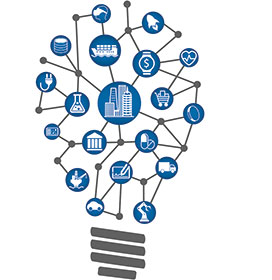

Business goals during the Industrial Internet of Things (IIoT) era are the same as those that have existed forever: reducing downtime, cutting costs and staying competitive.
What is different about the next industrial revolution is how we will meet these goals. This time the breakthrough in innovation involves interconnectivity and the self-regulation of machines, along with a dose of Big Data, to drive continuous improvement processes.
As an example, think of the challenges of predictive maintenance today. Currently a lot of maintenance work is reactive. No one wants to halt production to go digging through the guts of a machine unless that machine comes to a halt. With the Industrial Internet, however, machines will be able to monitor their own condition and give early warnings when vital parts are about to fail.
The overarching theme is that the data within control systems, historically used just for the operation of the system itself, also contains a wealth of useful information for running the business more effectively. When made available to business systems, this information can drive a wide range of new efficiencies along with other cost savings and revenue enhancements. Examples include:
• Better asset utilisation.
• Lower energy consumption.
• Better supply chain management.
• Predictive maintenance.
• Manufacturing as a service.
However, getting there in one giant leap simply is not practical; it is an evolutionary process. Let’s look at the changes that are occurring and the steps you can take now to move forward on the journey to IIoT.
Five steps to an IIoT-ready industrial network
When you think of everything that the IIoT might touch in your business over time, it can be a bit overwhelming. However, you don’t need to foresee everything you might want to do over the life of your network before taking your first step.
If you are early in your IIoT journey, we recommend a five-step process that will move you forward and help you realise benefits as soon as possible.
1. Assess and map industrial networking infrastructure
The first step is all about looking at the current state of your business and figuring out where you want to take it. Identifying where you are and where you want to go can often highlight the difficulties you need to overcome and make your approach much more focused.
Before you start to build a new system, you need to understand what you already have. What are the connectivity (wired/wireless, bandwidth, reliability) and environmental requirements of current systems? What are the near-term goals in terms of functionality and data exchange? The result of the assessment stage should be an accurate ‘map’ of your network’s infrastructure.
If you have a large network, you will save time and effort doing this by using Network Management Software (NMS) such as Industrial HiVision.
2. Migrate to Ethernet
After assessment, the migrate step is about looking at any existing legacy systems you might already have. Can they be repurposed or upgraded? You will want Ethernet to be the foundation of your communications infrastructure, so for existing components – such as sensors, actuators and electric motors – that communicate using fieldbus, plan their migration to Ethernet.
3. Update network design to meet best practices
This step is where we recommend you pause to make sure your program meets established best practices and standards. Belden has resources that can help.
An overview of design best practices is available here http://tinyurl.com/hzylypa. You can also read about how one of our customers, a pharmaceutical company, updated their network for the IIoT.
We also offer a no-charge Industrial Ethernet Infrastructure Design Check-Up that evaluates your network based on industry best practices.
4. Protect reliability and resiliency with Defense in Depth
Cyber security has become a bigger and bigger challenge in OT environments – and it is not just about attackers from motivated hackers. The majority of industrial security incidents are unintentional, resulting from human error, device flaws and accidental malware introductions. The IIoT, with its more-things-connecting-in-more-ways, only makes the challenge tougher.
If you are not sure where to begin, start out with a risk assessment. Then, identify your most critical assets and protect them first. Next, implement best practices such as Defense in Depth (overlapping layers of security) and the ISA IEC 62443 standard.
Cyber security is a big topic, one where Belden has made significant investments and has considerable expertise. In the past few decades, Belden representatives have not only participated in but been leaders in driving the adoption of new regulatory and technical standards across the industry.
5. Monitor for changes, anomalies and malware
The last step is a feedback loop into the first. Technology is constantly changing. Security threats are changing. Business needs are changing. You need to monitor all of these things and make changes to systems accordingly.
The IIoT is a journey
The IIoT is a journey, not a destination. Your industrial control system is dynamic and it will evolve over time. The key thing, however, is that if you follow the process we have outlined and think about things upfront. The industrial Ethernet infrastructure that you deploy today will provide a solid foundation to build on over time.
For resources to help you continue the IIoT journey, check the dedicated Belden IIoT website (http://info.belden.com/industrialinternetofthings), where you will find an updated list of resources covering the trends and technologies that are changing industry.

© Technews Publishing (Pty) Ltd | All Rights Reserved